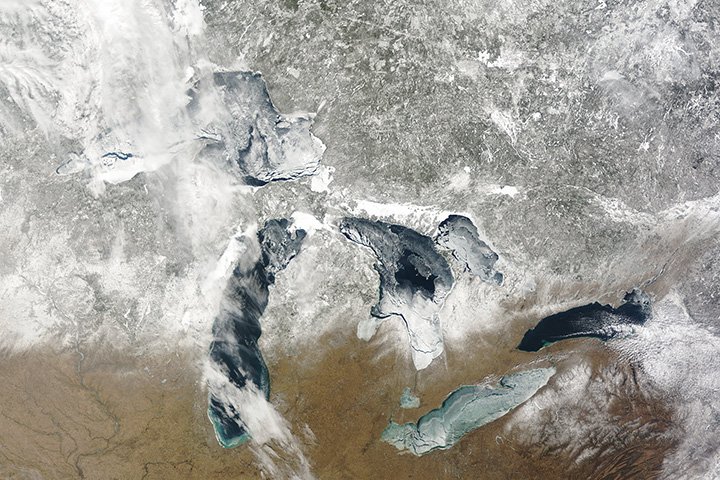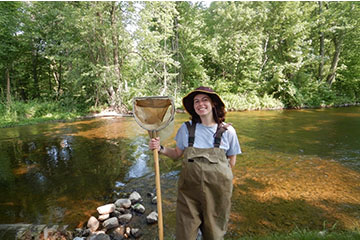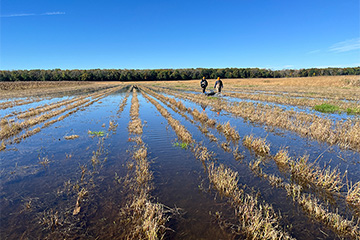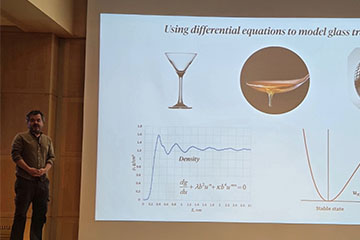Great Lakes scientists to study ‘the changing face of winter’
CMU among institutions taking part in rare February sampling
Nearly all scientific sampling of the Great Lakes is done between May and October, when the lakes are free of ice and the water is warmer.
But this month, scientists from more than a dozen U.S. and Canadian institutions, including Central Michigan University, will brave the elements to sample all five Great Lakes and Lake St. Clair in a first-of-its-kind coordinated campaign called the Winter Grab.
Teams will drill through ice to collect water samples, measure light levels at various depths and net tiny zooplankton as part of a broader effort to better understand the changing face of winter on the Great Lakes, where climate warming is increasing winter air temperatures, decreasing ice-cover extent and changing precipitation patterns.
The specific goal of the Winter Grab is to help fill key wintertime knowledge gaps about ice properties, water movement, nutrient concentrations and lake biology. The event is funded in part by the Cooperative Institute for Great Lakes Research at the University of Michigan, a partnership with the National Oceanic and Atmospheric Administration.
“Scientists have studied the Great Lakes extensively, but surprisingly, we know very little about what takes place during the winter,” said Don Uzarski, director of the CMU Institute for Great Lakes Research.

Uzarski is among the more than two dozen researchers who will travel on foot, by snowmobile and in all-terrain vehicles and sleds—one team is even planning to use a fan-driven airboat to glide across the ice—to collect samples at 20 to 30 locations during the week of Feb. 14, the date that historically marked peak ice cover extent on the Great Lakes. Some scientists will hitch rides aboard U.S. and Canadian Coast Guard icebreakers.
After a warm December, this winter had been on track for a near-record low in Great Lakes ice cover. But the ice rebounded significantly during a frigid January, providing a boost for Winter Grab participants, according to Uzarski.
“It allows us to safely get out onto the ice in some areas to collect data – otherwise, we would be using boats in areas where we could avoid the ice entirely, or we would be employing ice-breaking vessels where some ice is present but not enough to safely walk on,” said Uzarski.
CMU’s group will team up with University of Michigan scientists and their colleagues at NOAA’s Great Lakes Environmental Research Laboratory to sample in Lake Huron’s Saginaw Bay for the Winter Grab.
“My lab has sampled a bit during the winter months, but these data put things on a much bigger scale,” said Uzarski. “It gives us an opportunity to understand how those temperature swings impact the chemical, physical, and biological aspects of the ecosystem in one portion of one Great Lake versus what is happening all over.”
The scarcity of winter research on the Great Lakes has two main causes. The first is the logistical difficulty of conducting Great Lakes fieldwork in the winter when gale-force winds and unstable ice keep most research vessels in port and instrumented surface buoys onshore.
During the Winter Grab, all members will wear either a flotation suit or a life jacket when walking on the ice. They will check ice thickness frequently, and each person will carry a pair of “ice spikes,” hand-held ice picks used for self-rescue in the event of an accident.
The second reason for the lack of wintertime Great Lakes research is a longstanding belief among many limnologists that little of importance happens in lakes during the winter, a season-long viewed as a time of dormancy and senescence. But recent studies have begun to challenge that assumption.
“It was once believed that these ecosystems that freeze to some degree sort of go dormant, but we now know that is not the case at all,” said Uzarski. “What takes place during the wintertime with respect to chemical, physical, and biological aspects of the ecosystem is a piece of the puzzle that we have to understand in order to preserve, protect, and restore the ecosystem.”
Research teams will use gas- or battery-powered augers to bore through the ice and will record ice thickness and water depth. They will determine how snow and ice affect light levels at various depths by lowering light sensors into the holes. Water samples will be collected for nutrient analysis, and fine-meshed nets will be used to gather zooplankton from the water column.
In places where ice has not yet formed, scientists will sample the water from piers. Later, about 20 types of laboratory analyses will be done on all the Winter Grab samples. The work is expected to lead to peer-reviewed publications and new grant proposals.
In coming years, with sufficient funding, Great Lakes winter research could be expanded to include the use of dedicated ice-strengthened or ice-breaking research vessels—perhaps even the deployment of autonomous sensor platforms beneath the ice. Closing the wintertime blind spot on the Great Lakes, the world’s largest freshwater ecosystem, will also require broader recognition of the value of such work and greater collaboration among scientists.
In addition to Central Michigan University (Uzarski and Carrick Labs), participating U.S. colleges and universities include the University of Michigan, Michigan Technological University, Bowling Green State University, Oberlin College, Wright State University, Lake Superior State University, Ohio State University, Clarkson University, the University of Minnesota Duluth and the University of Chicago.
Participating Canadian universities are the University of Windsor, Lakehead University and Trent University. Participating U.S. and Canadian government agencies are the NOAA Great Lakes Environmental Research Laboratory, and Environment and Climate Change Canada. Funding was provided by the Cooperative Institute for Great Lakes Research, which is hosted by the University of Michigan School for Environment and Sustainability.



